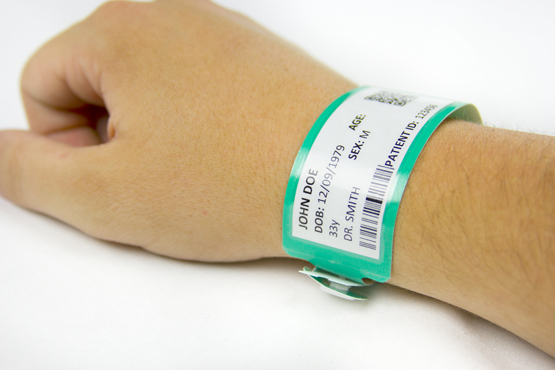Exploring the Numerous Kinds Of Patient Identification Band Utilized in Clinical Facilities
In the elaborate world of medical care, the vital duty of Patient Identification bands commonly goes undetected. These bands, differing from straightforward paper wristbands to sophisticated RFID bands, create the foundation of Patient safety procedures, ensuring precision in Patient Identification.
Recognizing the Value of Patient Identification Bands
While they might seem like plain devices, Patient Identification bands play a crucial role in medical centers. These bands offer as a vital device for validating Patient identification, stopping medical errors related to misidentification. Patient Identification bands likewise aid in streamlining management jobs, ensuring precise record-keeping and billing.
Traditional Paper Wristbands: Their Use and Limitations
Conventional paper wristbands have been a staple in Patient Identification across various clinical facilities. While their use is extensive, they nurture specific constraints that might impact their effectiveness in Patient management. This area will concentrate on the range of their application and the intrinsic disadvantages connected with their usage.
Paper Wristbands: Use Range
In the world of Patient Identification, paper wristbands have actually long held an important function. These bands are commonly made use of in outpatient settings, where the Patient's stay is short-term. Regardless of improvements in technology, the humble paper wristband remains a dependable and affordable option for Patient Identification in different healthcare situations.
Limitations of Paper Wristbands
Regardless of their extensive usage, paper wristbands are not without their disadvantages. Their physical longevity is among the considerable constraints. Direct exposure to water, sweat, or rough handling can provide them unreadable or also cause them to degenerate. Furthermore, paper wristbands frequently do not have the technological abilities of more modern choices, such as barcoding or RFID chips, restricting their performance to just presenting created details. The failure to upgrade or modify the information on the wristband is one more drawback. In addition, if the details is transcribed, readability can be jeopardized, causing possible misidentification. Ultimately, paper wristbands can trigger pain or skin inflammation to some clients, particularly when used for prolonged durations.
Barcoded Wristbands: Developments in Patient Identification
While Patient Identification has long been a crucial element of health care, the advent of barcoded wristbands represents a significant jump forward. These bands take advantage of the simplicity of barcoding innovation, permitting Patient details to be rapidly scanned and accessed. They enhance the speed and precision of Patient Identification, decreasing the threat of medical mistakes connected to misidentification. Barcoded wristbands are cost-efficient, easy to create, and get rid of handwriting mistakes usual with manual systems. They are not without constraints. While they use enhancements over conventional bands, the barcode can end up being used or smudged, providing it unreadable. Regardless of this, barcoded wristbands remain an important device in modern healthcare settings, representing the junction of technology and Patient treatment.
Radio Frequency Identification (RFID) Bands: an Action Towards Futuristic Health Care
The development of Patient Identification bands has actually caused the development of Radio Regularity Identification (RFID) Bands (patient identification band). These innovative devices present vital benefits for health care centers, offering a more reliable and highly advanced ways of Patient Identification. The implementation of RFID in health care is a substantial step in the direction of a much more advanced approach to Patient management and safety and security
Recognizing RFID Bands

RFID Bands: Secret Benefits
Accepting a future where modern technology and health care merge, radio regularity Identification bands provide a discover this number of vital advantages. Primarily, these bands enhance Patient safety by supplying exact, instant Identification, consequently decreasing medical mistakes. RFID bands can save a large amount of Patient information, consisting of clinical history and allergies, making it possible for personalized treatment. They also streamline administrative tasks, as the automated information entry changes hands-on procedures, improving performance and lowering paperwork. RFID bands use real-time tracking of people, essential in high-risk environments such as surgical procedure or extensive treatment. Last but not least, these bands are immune and sturdy to ecological elements, making certain consistent functionality. Overall, RFID bands represent a substantial improvement in Patient Identification innovation, benefiting both patients and doctor.
Implementing RFID in Healthcare
As we step into a technically sophisticated era, the implementation of RFID bands in healthcare ends up being progressively essential. These bands supply a smooth method to track and a knockout post identify people, guaranteeing their security and boosting performance in treatment procedures. RFID bands use numerous advantages over conventional Identification techniques. They can keep a huge quantity of data, including the Patient's clinical background and treatment strategies, which can be quickly accessed by doctor. This data helps doctors make informed decisions concerning the Patient's treatment strategy. Moreover, RFID bands minimize medical mistakes by supplying precise Patient Identification, which is essential in avoiding misdiagnosis or incorrect medication administration. Thus, the execution of RFID bands is a significant step in the direction of boosting Patient security and medical care shipment.

Color-Coded Wristbands: Helping in Quick and Accurate Medical Diagnosis
In the bustling environment of a clinical center, color-coded wristbands have arised as crucial tools for swift and specific Identification original site of a client's medical condition. These wristbands, put on by people, carry specific shades that correspond to different medical problems or statuses. This system is created to use instant visual cues to healthcare service providers, enhancing Patient safety and security and care top quality.
Strategies for Reliable Application and Administration of Patient ID Bands
Attaining ideal usage of Patient Identification bands requires a well-structured approach for their execution and administration. Patient education and learning is likewise crucial; people have to understand the purpose of the bands and the demand for their continuous wear. It's essential to have a backup plan in location, such as barcode scanning or biometrics, to ensure that Patient Identification is never ever compromised.
Final thought
Patient Identification bands are vital in clinical centers to guarantee security and accuracy. Effective execution and management of these bands can dramatically decrease medical mistakes, improve efficiency, and improve total Patient treatment.
These bands, differing from easy paper wristbands to advanced RFID bands, develop the backbone of Patient security methods, guaranteeing precision in Patient Identification.The advancement of Patient Identification bands has actually brought regarding the development of Radio Frequency Identification (RFID) Bands. In general, RFID bands represent a substantial innovation in Patient Identification modern technology, benefiting both patients and healthcare providers.
RFID bands decrease medical errors by supplying exact Patient Identification, which is crucial in protecting against misdiagnosis or incorrect medication administration. Patient education is likewise critical; patients should recognize the objective of the bands and the demand for their continuous wear.